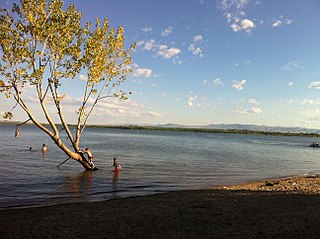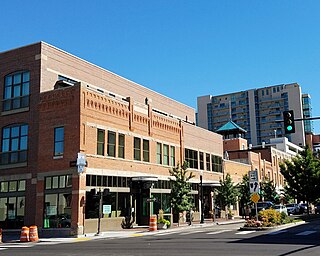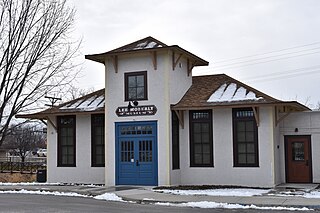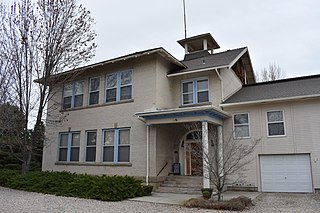
The Deer Flat National Wildlife Refuge is an important breeding area for mammals, birds, and other animals. The National Wildlife Refuge is located on land surrounding Lake Lowell, just outside Nampa, Idaho. It serves as a resting and wintering area for birds, including mallards and Canada geese, along the Pacific Flyway and was named a "Globally Important Bird Area" by the American Bird Conservancy.

The Boise City National Bank building in Boise, Idaho, was designed by architect James King as a 3-story, Richardsonian Romanesque commercial structure, inspired by the Marshall Field's Wholesale Store in Chicago. Construction began in April, 1891, and the building was completed in 1892.

Walter E. Pierce was a prominent real estate speculator in Boise City, Idaho, USA, in the late 19th century and in the first half of the 20th century. Pierce served as mayor of Boise City 1895-97 as it evolved from being a frontier community to being a modern town.

The Idaho Building in Boise, Idaho, is a 6-story, Second Renaissance Revival commercial structure designed by Chicago architect, Henry John Schlacks. Constructed for Boise City real estate developer Walter E. Pierce in 1910–11, the building represented local aspirations that Boise City would become another Chicago. The facade features brick pilasters above a ground floor stone base, separated by seven bays with large plate glass windows in each bay. Terracotta separates the floors, with ornamentation at the sixth floor below a denticulated cornice of galvanized iron.

The South Eighth Street Historic District in Boise, Idaho, is an area of approximately 8 acres (3.2 ha) that includes 22 commercial buildings generally constructed between 1902 and 1915. The buildings are of brick, many with stone cornices and rounded arches, and are between one and four stories in height. The area had been Boise's warehouse district, and many of the buildings were constructed adjacent to railroad tracks that separated downtown from its industrial core. The district is bounded by Broad and Fulton Streets and 8th and 9th Streets.

St. Alphonsus Hospital was a three-story, French Renaissance style building in Boise, Idaho, designed by architect J.K. Hollowell in 1893. Completed in 1894, the hospital was part of a small group of buildings constructed by the Roman Catholic Diocese of Boise that included St. Teresa's Academy (demolished).

The Idaho State Forester's Building, also known as The Cabin, in Boise, Idaho, is a 1+1⁄2-story log cabin designed by Boise Payette Lumber Company architect Hans C. Hulbe and constructed in 1940 by round-log artists John Heillila and Gust Lapinoja. Logs for the cabin are peeled Engelmann spruce with full dovetail notch and oakum chinking. Inside paneling on office walls includes yellow pine, white pine, and western red cedar, and all of the wood came from Idaho forests and was donated by lumber companies with business interests in Idaho. The building was added to the National Register of Historic Places in 1997.

The United States Post Office - Nampa Main, also known as the Herbert A. Littleton Postal Station, in Nampa, Idaho, is a two-story Neoclassical building completed in 1931. James A. Wetmore was the supervising architect. The building was added to the National Register of Historic Places in 1989.

The Idaho National Guard Armory in Boise, Idaho, is an unreinforced, poured concrete building designed by Tourtellotte & Hummel and constructed in three phases beginning with a 1-story section in 1931. The building includes a drill hall large enough for equestrian events and a 2-story office area completed in 1956. The facade is minimally decorated and features Art Deco elements, including a cornice of stepped concrete bands, projecting pilasters, and zigzag patterning.

The Mitchell Hotel in Boise, Idaho, was a 2-story, brick and stone building designed by Tourtellotte & Co. and constructed in 1906. The building featured segmentally arched fenestrations with "denticulated surrounds of header brick." The building was listed on the National Register of Historic Places (NRHP) in 1982.

The Cyrus Jacobs House, also known as the Cyrus Jacobs-Uberuaga House and the Basque Museum and Cultural Center, in Boise, Idaho, is a 1+1⁄2-story brick house constructed by Charles May in 1864. The house was added to the National Register of Historic Places in 1972.

The Nathan Smith House in Boise, Idaho, is a 1+1⁄2-story Colonial Revival farmhouse designed by John E. Tourtellotte and constructed in 1900. The house features a veneer of cobblestones from the Boise River below shingled upper gables and hooded dimple windows, but its most prominent design element is a front facing basket arch balcony above the porch. The overall design is an early example of a Bungalow, and it influenced later designs in Boise. The house was added to the National Register of Historic Places in 1983.

The Mrs. A.F. Rossi House in Boise, Idaho, is a one-story cottage in the Colonial Revival style with "proto-bungaloid" elements. The house was designed by Tourtellotte & Co. and constructed in 1906. Its prominent feature is an outset, left front center porch. In 1982, the house was added to the National Register of Historic Places.

The New York Canal is an irrigation canal in the western United States, located in southwestern Idaho. Sourced from the Boise River, it originates at the Diversion Dam in Ada County and ends after 41 miles (66 km) at Lake Lowell in Canyon County.

The Middleton Substation is a 1-story, Italianate building in Middleton, Idaho, that was part of an interurban railway loop that connected Middleton, Boise, Nampa, and Caldwell. Constructed in 1912, the small, 16-ft by 30-ft substation provided space both for transformers and for an office. The Middleton Substation was added to the National Register of Historic Places in 1973, and its nomination included an adjacent generator building constructed in 1907 and later demolished.

The Emerson and Lucretia Sensenig House, also known as the Marjorie Vogel House, is a 2+1⁄2-story Foursquare house in Boise, Idaho, designed by Watson Vernon and constructed in 1905. The house features a hip roof with centered dormers and a half hip roof over a prominent, wraparound porch. Porch and first-floor walls are brick, and second-floor walls are covered with square shingle veneer. A second-story shadow box with four posts is inset to the left of a Palladian style window, emphasized by three curved rows of shingles. The house was added to the National Register of Historic Places in 1997.

The William Dunbar House in Boise, Idaho, is a 1-story Colonial Revival cottage designed by Tourtellotte & Hummel and constructed by contractor J.O. Jordan in 1923. The house features clapboard siding and lunettes centered within lateral gables, decorated by classicizing eave returns. A small, gabled front portico with barrel vault supported by fluted Doric columns and pilasters decorates the main entry on Hays Street. The house was listed on the National Register of Historic Places in 1982.

Franklin School was a two-story brick and stucco building in the western United States, located in Boise, Idaho. Designed by Tourtellotte & Hummel and constructed in 1926, the school featured a flat roof with a decorated concrete parapet. Added to the National Register of Historic Places (NRHP) in 1982, it was demolished in 2009.

Ustick School in Boise, Idaho, is a 2-story, 4-room Colonial Revival schoolhouse constructed in 1909 in the former town of Ustick. The school was added to the National Register of Historic Places (NRHP) in 1982.

The Meridian Exchange Bank in Meridian, Idaho, was designed by the Boise architectural firm of Tourtellotte & Co. and constructed in 1906. Charles Hummel may have been the supervising architect. The 2-story, Renaissance Revival building was constructed of brick and sandstone by contractors Allen & Barber, and it featured a corner entry at Idaho Avenue and Second Street. The ground floor entry and a Second Street entry to the second floor both were framed by shallow brick pilasters supporting simple stone capitals. Four corbelled brick chimneys extended above the second floor parapet. The Meridian Exchange Bank and a barbershop occupied the ground floor, and the Independent Telephone Exchange rented the second floor. The building was added to the National Register of Historic Places (NRHP) in 1982.






















